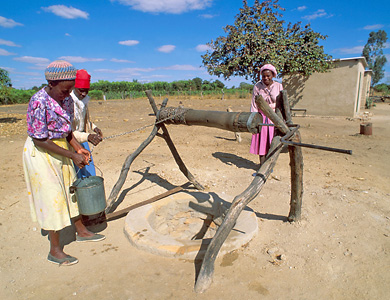Wheel and axle is a mechanical device used in lifting loads. It is one of the six simple machines developed in ancient times and ranks as one of the most important inventions in history. The simplest wheel and axle has a cylinder and a large wheel, fastened together and turning on the same axis. The wheel and axle is a first-class lever (see Lever). The center of the axle (the cylinder) corresponds to the fulcrum. The radius of the axle corresponds to the load arm. The radius of the wheel corresponds to the force, or effort, arm to which force is applied. Sometimes a crank is used instead of a wheel.

The advantage of a wheel and axle
is that it can lift heavy loads with little effort on our part. The following law gives the ratio between the two: The force applied multiplied by the radius of the wheel equals the load multiplied by the radius of the axle. To reduce this to a formula, let F stand for force; R for the radius of the wheel; L for the load; and r for the radius of the axle.

The mechanical advantage of a machine is always the ratio of the load (L) to the applied force (F) (see Machine (Mechanical advantage)). Let us use an example in which the radius of the wheel (R) is 10 inches, the radius of the axle (r) is 1 inch, and the load (L) is 20 pounds. If there were no friction, the formula would be 20/F = 10/1. Since 10F = 20, the force needed would be the same as that normally used to lift a mere 2 pounds. The mechanical advantage, the ratio of L to F, would be 20/2, or 10.
Uses of the wheel and axle.
In the ordinary windlass used for raising water from a well, a crank replaces the wheel. The hand applies the effort to the crank. The weight of the bucket of water is the load. In a grindstone, the radius of the wheel is usually longer than the crank handle, because speed is needed as well as force. Sometimes teeth or cogs may be placed around the edge of the wheel, as in a cogwheel, or on the sprocket wheel of a bicycle.
